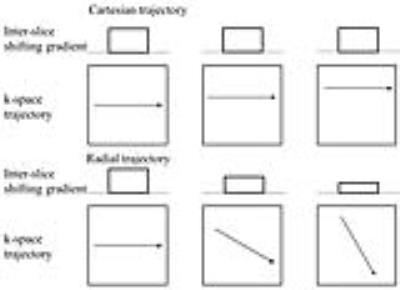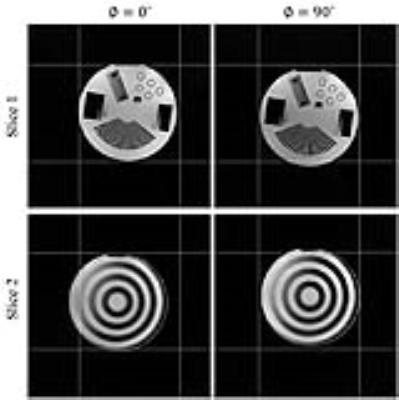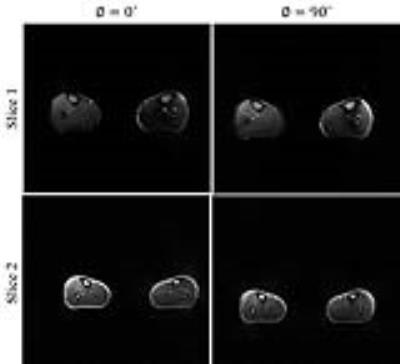3853
Simultaneous multi-slice (SMS) imaging technique for radial trajectory using inter-slice shifting gradient.1Gachon University, Incheon, Korea, Republic of, 2Korea Advanced Institute of Science and Technology, Daejeon, Korea, Republic of
Synopsis
SMS imaging techniques utilized phase modulated RF pulses, blipped gradients, or inter-slice shifting gradients to increase the use of sensitivity information of multi-channel coils. In this work, we extended the use of inter-slice shifting gradient based SMS techniques of a Cartesian trajectory to a radial trajectory. We modulated the ratio between inter-slice shifting gradient and readout gradient (i.e. view angle) with the cosine function. In addition, we adjusted the direction of shift of each slice by adjusting the offset of cosine function, thereby increase sampling efficiency of a radial trajectory when the imaging objects need an anisotropic field-of-view.
Introduction
Simultaneous multi-slice (SMS) imaging techniques were developed to reduce imaging time without the loss of signal to noise ratio (SNR) by using the multi-band RF pulses. In SMS imaging techniques, the efficient utilization of sensitivity information of multi-channel coil determines the quality of reconstructed images. Thus, imaging techniques were developed to use the sensitivity information in all spatial directions by using the phase modulated RF pulses1, blipped gradients2, or inter-slice shift gradients3,4, and these techniques were successfully applied to a Cartesian trajectory. Recently, SMS imaging techniques were applied to a non-Cartesian trajectory to combine the benefits of non-Cartesian trajectory with SMS imaging techniques5. In this abstract, we proposed a new SMS imaging techniques for radial trajectory using inter-slice shift gradient, which could shift simultaneously acquired slices in any directions by adjusting the offset of cosine modulation function. Therefore, the proposed method could increase the sampling efficiency of a radial trajectory.Method
The schematic diagram of the proposed method is shown in Fig. 1. The wide-band SMS imaging technique3 and the multi-slice image generation using intra-slice parallel imaging and inter-slice shifting (MAGGULLI)4 used inter-slice shifting gradient (i.e. view angle tilting gradient) to use the sensitivity information in readout direction. In radial trajectory, the magnitude of inter-slice shifting gradient should be adjusted, because the direction of readout is varied by each radial spoke (Fig. 1). The magnitude of inter-slice shifting gradient can be described as follows,
$$G_{z} =A\cos(\theta+\phi)$$
where Gz is the magnitude of inter-slice shifting gradient, A is the maximum magnitude of inter-slice shifting gradient, $$$ \theta $$$ is the angle of each radial spoke and $$$ \phi $$$ is the offset of cosine modulation function.
Result
Phantom and in-vivo experiments were performed at a 3.0T MRI system (Siemens Magnetom Verio, Erlagen, Germany) with a 12 channel head coil. Phantom images were acquired using the following parameters; field-of-view (FOV) = 256 × 256 mm2, slice thickness = 3 mm, flip angle = 40°, and TR/TE = 8.5/6 ms. In-vivo images were acquired with the same parameters of phantom experiments except FOV (FOV = 384 × 384 mm2). As shown in Fig. 2 and 3, the proposed method could shift simultaneously acquired slices to the selected direction by adjusting the offset of cosine modulation function.Discussion
A uniform spoke density of radial trajectory leads to a circular field of view (FOV), which reduces sampling efficiency when MR images are acquired from the objects with an anisotropic FOV (peripheral, abdomen, etc.). In the proposed method, we can shift simultaneously acquired slices to any desired direction by adjusting the offset of cosine modulation function ($$$ \phi $$$). Therefore, the proposed method increases the sampling efficiency of the radial trajectory. In a practical situation, the sensitivity variations of multi-channel array coil are not identical in all imaging directions. Thus, the direction of shift of simultaneously acquired slices affects the quality of reconstructed images. In the proposed method, we could select the direction of the shift with the consideration of coil configurations, thereby increase the quality of reconstructed images.Conclusion
In this work, we proposed a new SMS imaging techniques for a radial trajectory, which could shift simultaneously acquired slices to any desired direction. Therefore, the proposed method increases the sampling efficiency of radial trajectory.Acknowledgements
This research was partly supported by the Brain Research Program through the National Research Foundation of Korea (NRF) funded by the Ministry of Science, ICT & Future Planning (2014M3C7033998) and by a grant of the Korea Health Technology R&D Project through the Korea Health Industry Development Institute (KHIDI), funded by the Ministry for Health and Welfare, Korea (HI14C1135 ).References
1. Breuer F, Blaimer M, Heidemann RM, et al. Controlled aliasing in parallel imaging results in higher acceleration (CAIPIRINHA) for multi-slice imaging. 2005. Magn Reson Med. 53(3) 684-691.
2. Setsompop K, Gagoski B, Polimeni JR, et al. Blipped-controlled aliasing in parallel imaging for simultaneous multislice echo planar imaging with reduced g-factor penalty. 2012. Magn Reson Med. 67(5) 1210-24.
3. Paley MNJ, Lee KJ, Wild JM, et al. Simultaneous parallel inclined readout image technique. Magn Reson Imaging. 2006. 24(5) 557-62.
4. Kim D, Seo H, Oh C, et al., Multi-slice imAGe generation using intra-slice paraLLel imaging and Inter-slice shifting (MAGGULLI). Phy. Med. Bio. 2016. 61(4).
5. Yutzy SR, Seiberlich N, Duerk JL, Griswold MA, Improvements in multislice parallel imaging using radial CAIPIRINHA. Magn. Reson. Med. 2011. 65(6).
Figures



